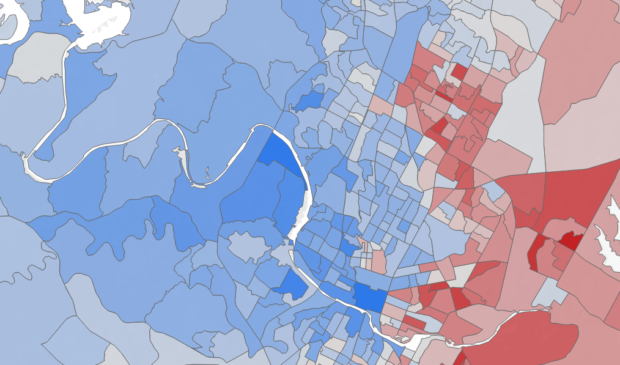UT professor maps climate vulnerability in Austin
Wednesday, February 12, 2020 by
Jessi Devenyns Communities within Austin are disproportionately affected by climate change based on their social vulnerability.
Social vulnerability refers to a community’s sensitivity to natural hazards and community members’ capacity to rebound from natural disasters.
In a study by Patrick Bixler with the University of Texas LBJ School of Public Affairs, 18 variables of social vulnerability were measured against the environmental hazards of flood, fire and heat to create a map of the most vulnerable areas in Austin.
Bixler came to the Feb. 5 meeting of the Environmental Commission to present the study’s findings and elaborate on the interaction between social vulnerability and risk exposure. When risk factors were superimposed on socially vulnerable areas within Austin, East Austin and North Central Austin stood out as areas that were at the highest risk of experiencing the hazards associated with climate change.
“This research is relatively fresh,” Bixler told commissioners, which he said makes it most relevant to use when crafting climate policy.
With climate change expected to bring more extreme weather to Austin, Bixler said preparing communities should be at the forefront of climate-related policy discussions. Beyond infrastructure updates and new building codes, he said investing in community resilience is a way to shape the outcome and future of different parts of Austin.
One way to reduce social vulnerability is by increasing the adaptability of communities. Since social capital plays a key role in a community’s adaptability, Bixler told commissioners that trusting one’s neighbors and having a strong network is “strongly predictive” of a household’s preparedness for disasters.
The overall vulnerability of the census tracts within Austin was measured against 18 variables, which Bixler put into six demographic categories: wealth, age, housing status, social status, gender, and language and education. This data is readily available to be updated in order to track the efficacy of climate-related policy changes in the coming years, he said.
Wildfire risk exposure was one of the three risk categories that factored into the mapping. Although West Austin is known to be at risk and Council members of those districts are advocating for the implementation of a wildland-urban interface code, the new UT mapping shows that areas of East Austin are at greater risk of exposure than the wooded canyons on the west side. However, wildfire exposure risk was widespread across the city. Data for this risk assessment came from the Austin-Travis County Wildfire Protection Plan.
Flood risk, on the other hand, was mainly concentrated to a few zones in East Austin, particularly the Dove Springs area. Data for this risk was based on creek flood exposure data from the city’s Watershed Protection Department and FEMA flood maps.
Heat risk was measured based on the amount of impervious cover and tree canopy. Most of this risk centered around the urban core with hot pockets in North Central Austin.
Assessing climate risk through this multifaceted lens prompted Environmental Officer Chris Herrington to approach the commission and ask it to “think about how we can bring in those considerations.” He was referring to the need for Watershed Protection Department policies to be formed using an equitable lens that focuses on climate change and not necessarily the climate of today.
Map depicts Austin Climate Vulnerability Score.
The Austin Monitor’s work is made possible by donations from the community. Though our reporting covers donors from time to time, we are careful to keep business and editorial efforts separate while maintaining transparency. A complete list of donors is available here, and our code of ethics is explained here.
You're a community leader
And we’re honored you look to us for serious, in-depth news. You know a strong community needs local and dedicated watchdog reporting. We’re here for you and that won’t change. Now will you take the powerful next step and support our nonprofit news organization?



